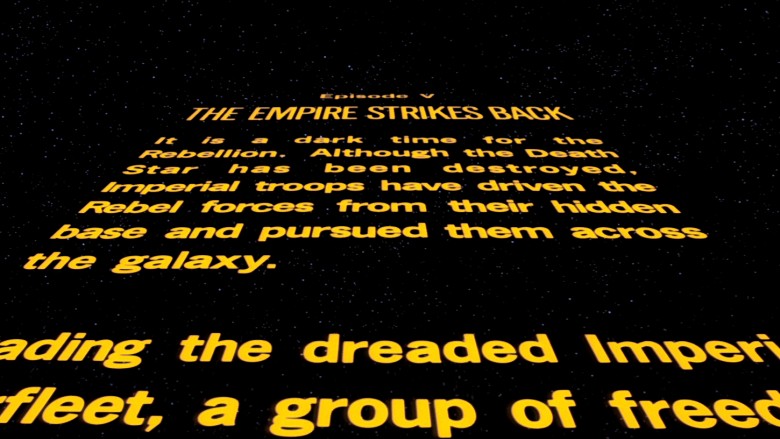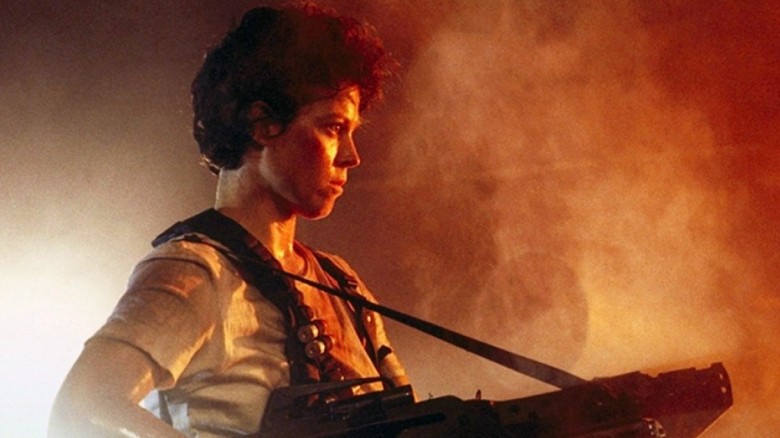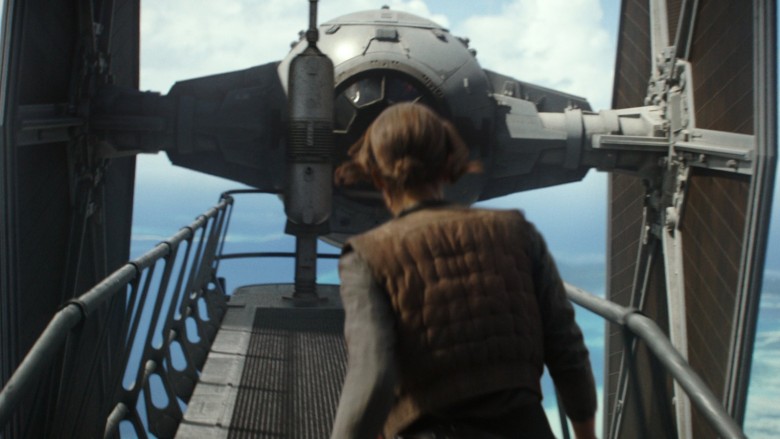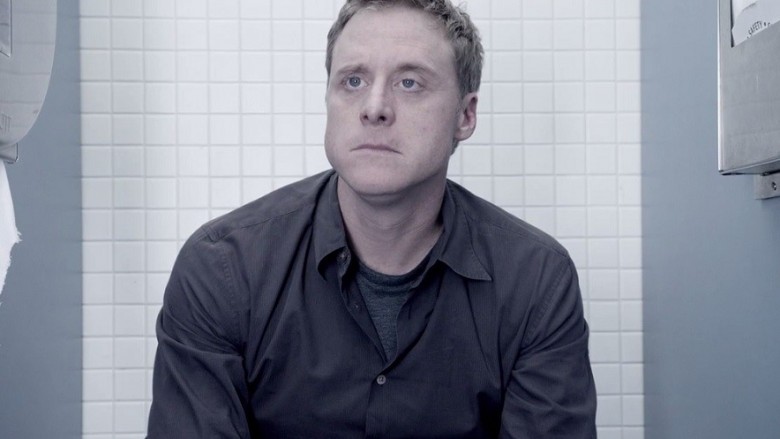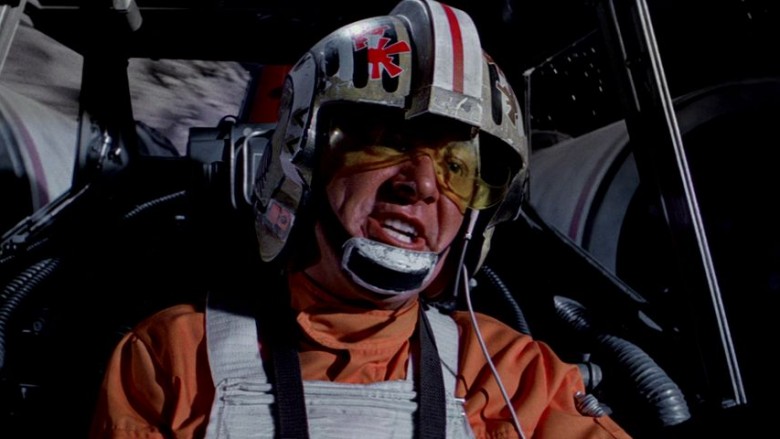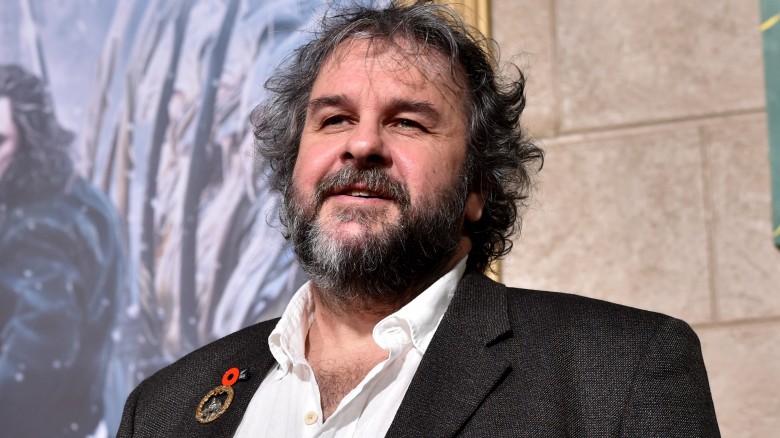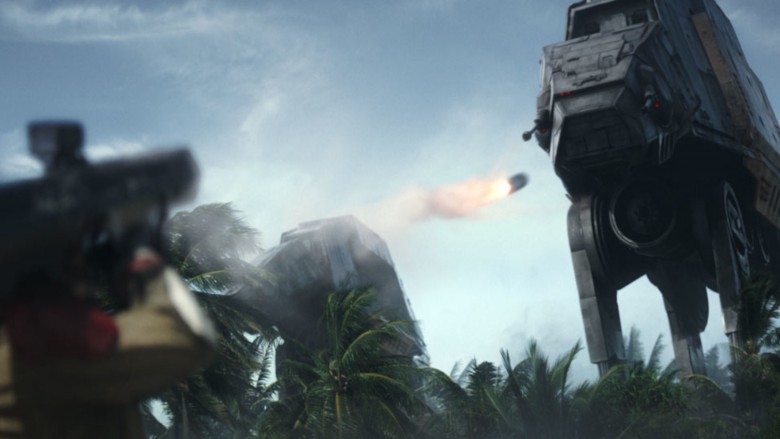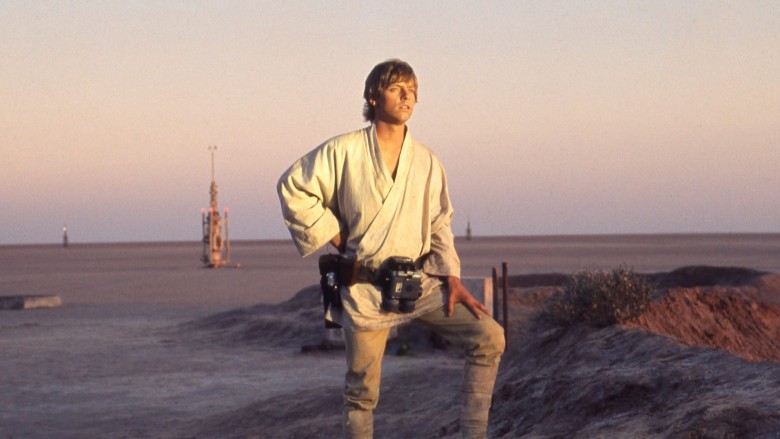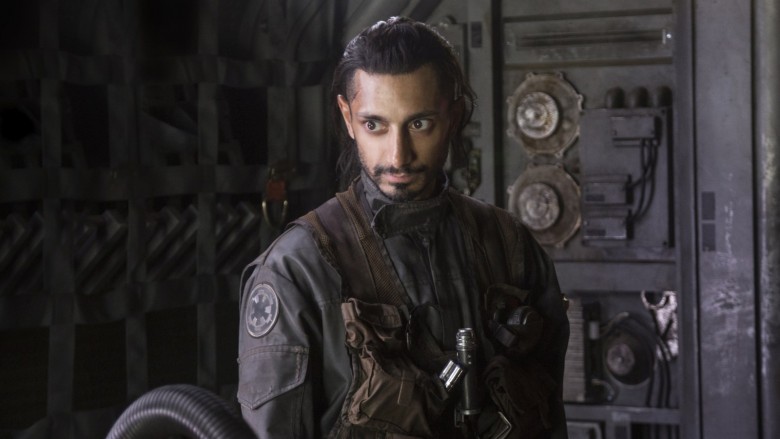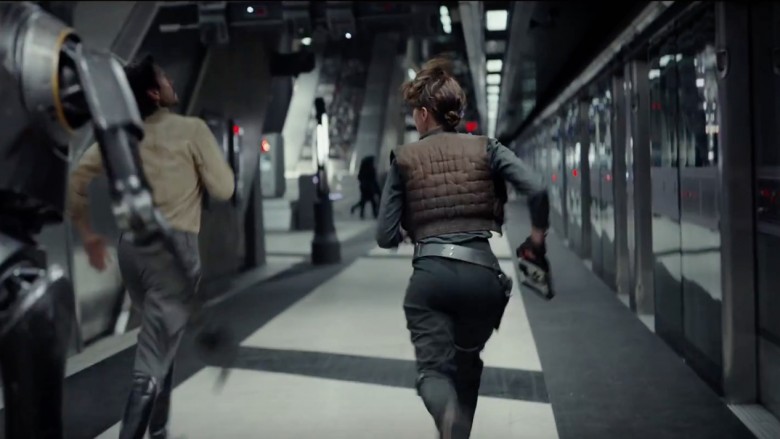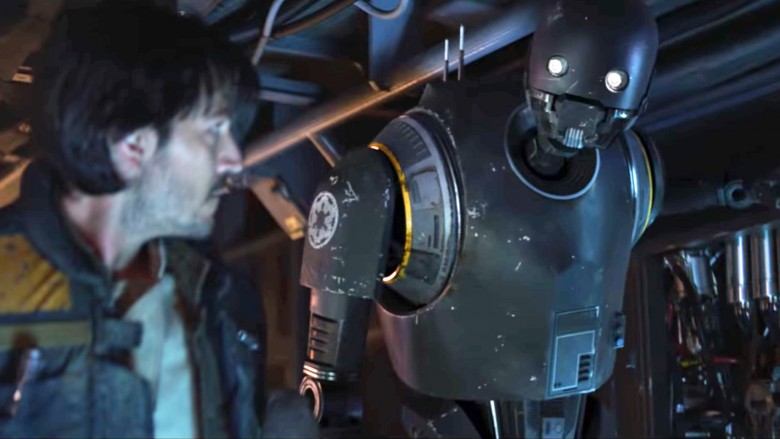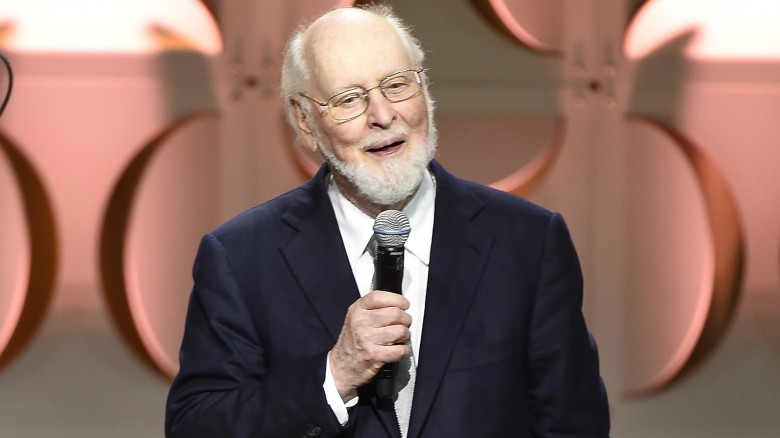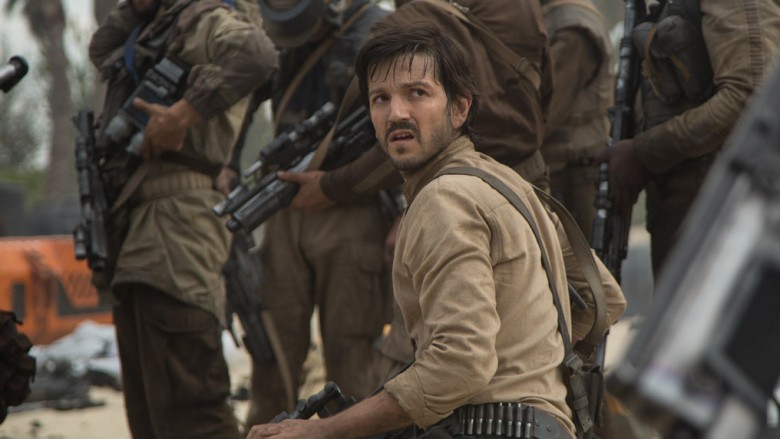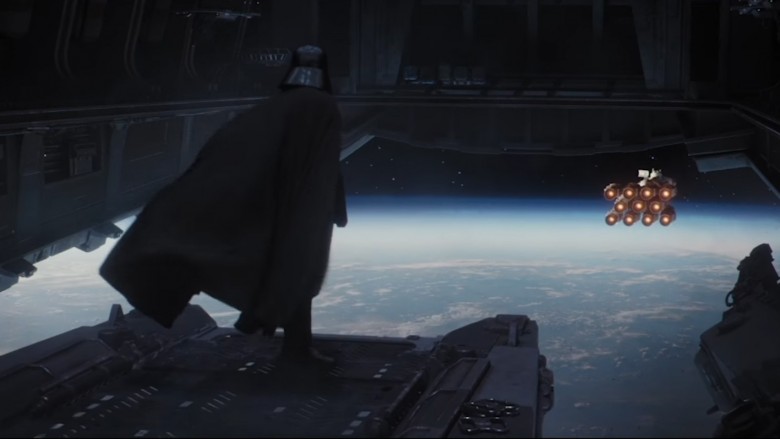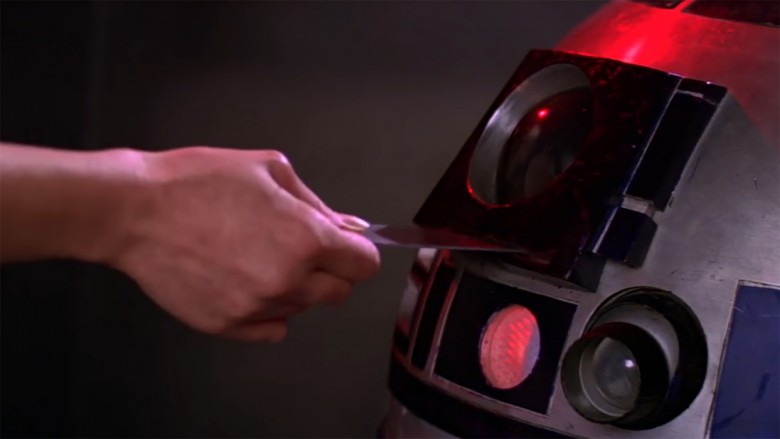The Untold Truth Of Rogue One
As the first true standalone story in the saga, there was a whole lot riding on Rogue One: A Star Wars Story—but the story surrounding the film is almost as interesting as the one we watched on the big screen.
From axed cameos to the film's fascinatingly humble beginnings, there's a whole lot more to Rogue One than just Jyn's quest to snag the Death Star plans. So let's dig into the untold truth of the latest hit Star Wars film.
Rogue One originally had a Star Wars opening crawl
Every prior Star Wars film has used a variation on the original's now-iconic opening crawl to deliver exposition and set the scene for the story to come. Rogue One jumps right into the action, but it turns out the first draft of the film actually had its own crawl—until director Gareth Edwards decided to remove it. The reason? Rogue One delves into a battle referenced in the opening crawl to A New Hope, so the creative team worried it would be a bit redundant to have an opening crawl for events already recapped in another opening crawl.
Rogue One was literally put together from pieces of other movies
Two of the film's editors, John Gilroy and Colin Goudie, revealed the film came together through a largely unorthodox approach. Instead of working off a script, they cut footage from hundreds of movies (e.g. WarGames, Aliens, etc.) to follow the scene-by-scene story breakdown. The reason? Edwards and everyone involved needed to figure out exactly how much dialogue the film would actually need, so they essentially "made" the film from other films to figure out how long these different sequences would take (breaking into a vault, Jyn's interrogation, etc.) so they could hash out a more detailed script. On the surface, it feels like the most backwards way to make a movie, but it worked out pretty well. Now we'd just like to get our hands on that mock-up reel...
They kept those deleted scenes in the trailers just because they were cool
The reshoots surrounding Rogue One have been reported exhaustively, with scene-by-scene breakdowns of everything that was left out of the final cut of the film. Edwards and the editing team undertook some extensive reshoots when putting together the final cut, and it's obvious entire subplots wound up on the cutting room floor. Why did all those early scenes remain in the trailers in the weeks and months leading up to release—long after it was obvious a lot of them would never be in the final cut? According to Edwards, it was a decision made on the marketing side, because the folks cutting those commercials and trailers felt they did a good job of selling the "spirit" of the film. Even if they're not actually in the movie anymore.
Alan Tudyk had a (human) cameo that didn't make it in
This one gets a little meta, so just bear with us: Alan Tudyk played the fan favorite droid K-2SO, and wore a motion capture rig to bring him to life, but he also popped up as a pilot in a scene that didn't actually make it into the final film. The funny part? Tudyk played the cameo role as his alter ego Wray Nerely, a self-deprecating sci-fi actor bouncing between fan conventions for work, from the actor's hit web series Con Man. Wray never has much luck landing and keeping big roles in the web series, and it seems even his real-life Rogue One cameo couldn't survive that (fictional) streak of bad luck. We told you this one was meta.
There's archival footage in the battle sequence
Edwards raided the vaults at Skywalker Ranch and Lucasfilm when putting together his final battle scene in Rogue One, to the point that he literally used some archived footage from the first Star Wars film. Keen-eyed fans noticed some familiar faces during the dogfight, and that's because Edwards discovered and painstakingly restored some unused alternate shots of the pilots during the Rebels' attack on the Death Star in A New Hope. Edwards included it as a nod for fans, but it's just one more subtle way that Rogue One enriches the faraway galaxy we know and love.
Peter Jackson watched the Vader scene being filmed
Peter Jackson might be the mind behind two of the biggest genre franchises in history, but even he has to tip his hat when Darth Vader's walking into the room. Jackson, the man behind the Lord of the Rings and Hobbit trilogies, just happened to be in town when Edwards was directing that epic closing scene when Darth Vader goes positively bonkers on the escaping Rebel agents with the Death Star plans. Edwards gave him a heads up for when he was filming, and Jackson ran over immediately to geek out over Vader mowing through a hallway of soldiers. Famous director or not, we can't blame Jackson for going fanboy and basking in Vader's glory. We'd have done the same thing.
An effects supervisor came up with the idea
The entire concept for Rogue One was born from about two sentences in the opening crawl to A New Hope, but it was a former visual effects supervisor for the original trilogy who had the bright idea to turn those lines into a full-fledged movie. FX guru John Knoll came up with the pitch back when Lucasfilm wanted to do a live action Star Wars series, and conceived it as a "Mission: Impossible-style story or infiltration mission." The idea was shelved when the live-action series failed to materialize, but when Disney bought the franchise and announced plans to do standalone stories, Knoll dug it back out and started running it by colleagues at the Lucasfilm office. Everyone loved it, and encouraged him to make an appointment with president Kathleen Kennedy and the story group tasked with keeping track of the new canon. They also loved it, and a blockbuster film was born.
They used vintage camera lenses to get that 1970s look
Considering this film is supposed to lead right up to the opening moments of A New Hope, the pressure was on for Edwards to get the look just right in Rogue One—including making it look a little 1970s so it lines up with the aesthetics of the old Star Wars trilogy. To get it right, Edwards used the vintage Ultra Panavision 70mm lenses Quentin Tarantino unearthed at Panavision for The Hateful Eight, and attached them to an ultra high-tech 6k large format camera. It proved the perfect combination of lo-fi and high tech, and allowed Edwards to strike the same balance that made the original trilogy look so memorable.
Riz Ahmed went way overboard in auditions
When Riz Ahmed was up for the role of the defecting pilot Bodhi Rook, he went a little overboard chasing down Edwards to try and lock down the gig. Edwards gave the actor his e-mail address, and Ahmed sent over two audition tapes to show his range. Edwards was pretty much sold right there, but had to take a few days to check with his superiors before offering him the role. In the meantime, Ahmed sent a dozen more audition tapes—pretty much clogging up the director's e-mail inbox. Thankfully, despite the annoyance, Edwards was still impressed enough to offer Ahmed the gig.
A London subway station doubled as the Empire base
The entire Star Wars saga has a very distinct look, which is why a lot of the film sets are typically either built from scratch or created with CGI—not many real-life structures look like they'd fit in this faraway world. Except, apparently, for the Canary Wharf subway station in London. The station was used as a double for the Empire base in the back half of the film, with several hallway and staging shots (some of which didn't actually make the final cut) set right inside the station that travelers use every day. Weirdly enough, the futuristic platform design is the spitting image of Empire decor.
Alan Tudyk wore stilts to bring K-2SO to life
The snarky droid K-2SO is around seven feet tall, while the actor bringing him to life is a foot or two shorter. Even though the character was created with motion capture and CGI, they still needed him to be around the same approximate height range while acting with the rest of the cast. The solution? Put Tudyk on stilts, which he wore for much of the production. It might sound like a hassle, but it sure beats having to wear an entire C-3PO costume—like Anthony Daniels had to do in the original trilogy. (Daniels agrees, as he profanely pointed out when meeting Tudyk in person.)
It's the first Star Wars film not scored by the legendary John Williams
Along with being the first standalone Star Wars film, Rogue One also marked the end of an era for franchise mainstay John Williams. The legendary composer has been responsible for the film series' scores for decades — but he didn't handle those duties for Rogue One. Instead, Edwards opted to bring in Michael Giacchino (The Incredibles, Dawn of the Planet of the Apes) to provide the tunes for Jyn's adventure. It's a bit jarring to see Star Wars without hearing Williams' score, but it works. Giacchino adds enough homages that it still "feels" like Star Wars, while also setting a different tone.
Everyone grew mustaches and mutton chops to match the 1970s aesthetic
There are a lot of reasons Star Wars feels decidedly of its own era—and a big one is the hairstyles. You have 1970s mustaches and mutton chops pretty much everywhere, and with Rogue One bridging the gap, Edwards made a point to ensure his film would also fit. The director asked the extras (and some stars) to grow out their hair in 1970s styles so they would have the look of the era they were trying to recreate, and it travels all the way down to the facial hair Cassian's rocking throughout the story. It isn't Luke's floppy hair, but hey—nobody wants that.
Vader's climactic fight scene almost wasn't in the film
According to many fans, Darth Vader's climactic battle scene, in which the Sith Lord lays waste to Rebel troops as he tries to recapture the Death Star plans, is the best part of Rogue One. That's amazing, given that it almost didn't happen. As Gareth Edwards told Wired, while cutting the film, editor Jabez Olssen came up with the idea of giving Vader one final, terrifying moment before the end of the film. The only problem? Rogue One: A Star Wars Story was set to debut in about four months. Lucasfilm president Kathleen Kennedy, Edwards, and the rest of the Rogue One team rushed into production, filming Vader's rampage in just three days.
But Edwards didn't just cobble together a fun, exciting action scene—the sequence is full of Easter eggs, too. Every single one of Darth's moves is something that he does at various points during the original Star Wars trilogy, while Edwards himself appears as the fleeing Rebel soldiers—specifically, the one who pulls the lever and sends Princess Leia's ship on its way and whom Edwards calls "the savior of the entire Rebellion."
Gareth Edwards stole the Death Star plans
Everything about Star Wars is incredibly well-documented—even the most obscure background characters have names, backstories, and action figures. And yet, nobody knows what one of the most important props in the series—the card-like disk that holds the Death Star plans—originally looked like. Director Gareth Edwards said the disk only appears in a single shot in A New Hope, and even then, it's partly concealed by R2-D2. In order to recreate the object for Rogue One, the props department pored over a still captured from the Star Wars Blu-rays and tried to put together as faithful a recreation as possible.
And where is the disk now? "I took that prop," Edwards said. "I'm not saying where it is, but I did steal the Death Star plans."

